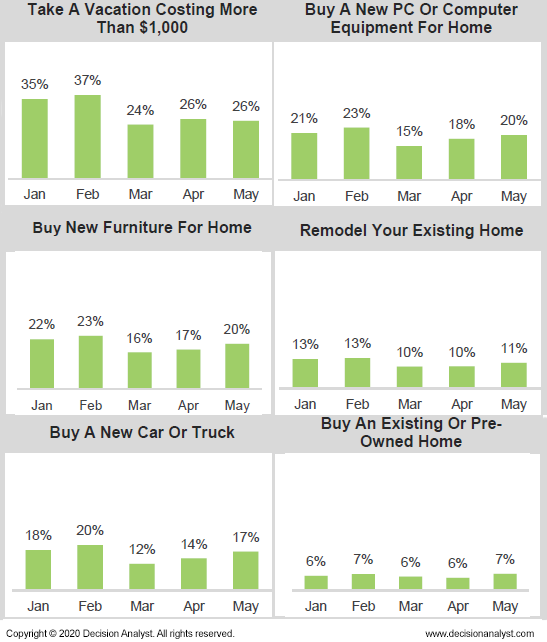U.S. Economy Appears Likely To Rebound Quickly
Arlington, Texas—The Decision Analyst U.S. Economic Index rose 6 points in May 2020 from a low of 91 in April 2020. From January 2020 to May 2020, the U.S. Economic Index fell 21 points, an unprecedented decline. Never in its 20-year history has the Economic Index fallen so far so fast. Below is a 20-year history of the U.S. Economic Index. It shows that the U.S. economy collapsed in March and April of 2020. The Index, however, tends to be forward-looking, as is evidenced by the 6-point increase in the Economic Index from April to May. The U.S. economy is still in recession; there’s no doubt about that. However, there are some glimmers of hope in the U.S. Economic Index and the other variables Decision Analyst tracks monthly. The U.S. Economic Index for the past 20 years is shown below.

“April or May 2020 might be the turning point that leads us out of recession,” said Jerry W. Thomas, President/CEO of Decision Analyst. “In addition to the uptick in the Economic Index in May, Decision Analyst also saw a slight decline in its unemployment rate for May 2020 from April, based on its methods of measuring unemployment. Decision Analyst’s U.S. unemployment data thus far in 2020 are shown in the chart below. Decision Analyst’s unemployment numbers tend to average 2-3 percentage points higher than BLS numbers because of differences in methodology, but this pattern reversed in April, when the official unemployment rate published by BLS soared to 14.7%.

In the Decision Analyst survey, U.S. adults have to self-classify their employment status, thus “unemployed but looking for a job” is to be counted as unemployed. The BLS’s April number was 14.7%, much higher than Decision Analyst’s unemployment number of 10.8%. The lower self-report employment rate by Decision Analyst suggests that fewer residents of the U.S. really think of themselves as unemployed compared to BLS data—which is focused on whether the person was unemployed during a specific one-week period each month. If fewer people actually think of themselves as unemployed, they might be likely to start spending or keep spending. This is one ray of hope for the future. The unemployment situation might not be as bad as reported by the BLS. And, the Decision Analyst unemployment rate actually improved a little in May (dropped from 10.8% in April to 10.4% in May).”
“A second ray of hope is evident in Decision Analyst’s intent-to-buy data,” said Thomas. “The graphs below show the percentage of U.S. households who say they are likely to do the following in the next 12 months.

“As evident in the graphs, the overall trend is upwards. Planned spending in each category has been stable or trending upward since March. New P.C. or Computer Equipment, New Furniture for Home, and New Car or Truck purchase intents are clearly on an upward path,” Thomas said. “These are positive indicators that the U.S. economy will strengthen in coming months. It will take time and lots of hard work to climb out of the current recession, but perhaps the economic trajectory is moving in the right direction,” Thomas concluded.
Methodology
The Decision Analyst Economic Index is based on a monthly online survey of several thousand households balanced by gender, age, and geography. The scientific survey is conducted in the last 10 days of each month. The Economic Index is calculated from 9 different economic measurements using a sophisticated econometric model. The result is a snapshot of coming economic activity in each country surveyed, as seen through the eyes of representative consumers living in the respective countries.
Decision Analyst conducts its concurrent economic surveys each month in Argentina, Brazil, Canada, Chile, Colombia, France, Germany, India, Italy, Mexico, Peru, the Russian Federation, Spain, and the United States. Whenever the Decision Analyst Economic Index is greater than 110, it tends to signal an expanding economy. An Index value of 90 to 110 suggests a no-growth or slow-growth economy, and near or below 90 generally indicates economic contraction. These guidelines vary by country, however.
About Decision Analyst
Decision Analyst (www.decisionanalyst.com) is a global marketing research and analytical consulting firm specializing in strategy research, new product development, advertising testing, and advanced modeling for marketing decision optimization. For over 40 years, the firm has delivered competitive advantage to clients throughout the world in consumer-packaged goods, telecommunications, retail, technology, medical, and automotive industries.
Media Contact
Cristi Allen
Publicity
Email: callen@decisionanalyst.com
Phone: 1-800-ANALYSIS (262-5974) or 1-817-640-6166
Address: 604 Avenue H East
Arlington, TX 76011
Library
Logos & Images
If you are doing a story on Decision Analyst or using any of our published data, news releases or articles, you must cite "Decision Analyst" as the source of the information.
If you use any of the charts or tables from the press releases or other published materials, please email Cristi Allen at callen@decisionanalyst.com to let us know which graphics you took and for what newspaper, magazine, or website it was used.

